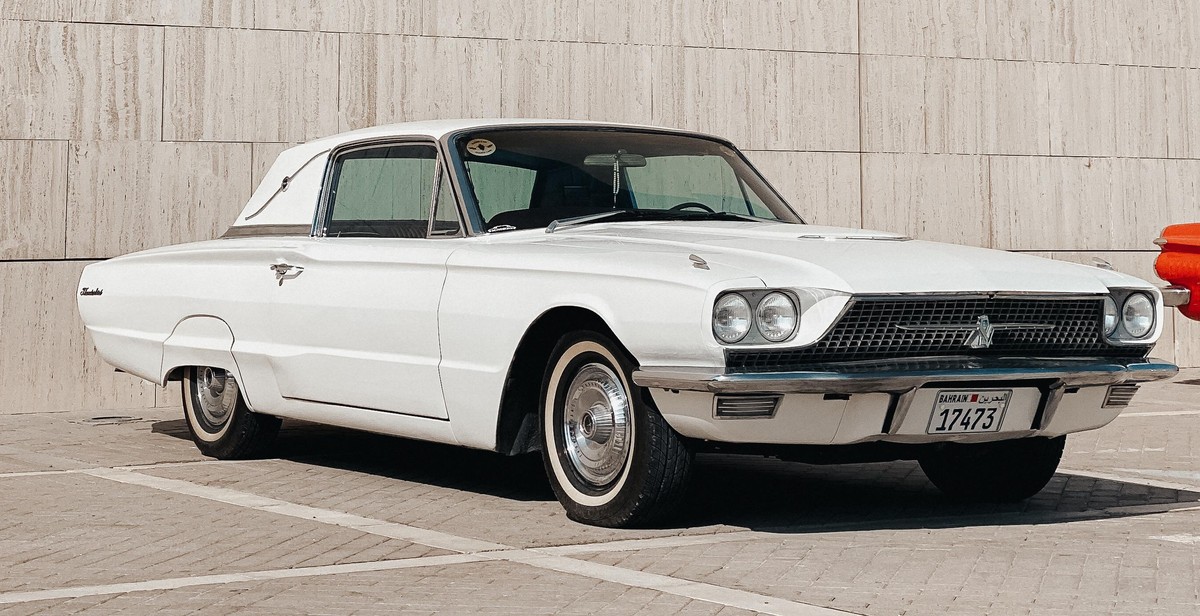Introduction
The 1950s was a golden era for American muscle cars, with their powerful engines and sleek designs captivating car enthusiasts. These iconic vehicles were known for their speed, power, and aggressive looks, making them a symbol of the American automotive industry’s dominance during that time. In this article, we will explore five of the most notable muscle cars from the 1950s that left a lasting impact on the automotive world.
1. Chevrolet Bel Air
The Chevrolet Bel Air is one of the most recognizable and beloved muscle cars of the 1950s. With its iconic tail fins, chrome accents, and powerful V8 engines, the Bel Air was a symbol of luxury and performance. It offered various engine options, including the legendary small-block V8, which became a staple in muscle car history.
2. Ford Thunderbird
The Ford Thunderbird, often referred to as the “T-Bird,” was introduced in 1955 and became an instant success. It combined the elements of a sports car with the comfort and style of a luxury vehicle. With its sleek design, powerful V8 engine, and advanced features, the Thunderbird set the standard for future generations of muscle cars.
3. Chrysler 300
The Chrysler 300, also known as the “Letter Series,” was a high-performance luxury car that made its debut in the 1950s. It featured a powerful HEMI V8 engine, advanced suspension system, and distinctive styling. The Chrysler 300 was not only a symbol of luxury but also a force to be reckoned with on the race track.
4. Pontiac Bonneville
The Pontiac Bonneville was a full-size luxury muscle car that made its mark in the 1950s. It offered powerful engine options, including the legendary Tri-Power V8, which delivered impressive performance. With its stylish design, comfortable interior, and advanced features, the Bonneville was a favorite among muscle car enthusiasts.
5. Dodge Coronet
The Dodge Coronet was a versatile muscle car that offered a range of engine options and body styles. It was known for its aggressive looks, powerful engines, and impressive performance. Whether it was a two-door coupe or a convertible, the Coronet was a true representation of American muscle cars in the 1950s.
In conclusion, the 1950s introduced some of the most iconic muscle cars in American automotive history. These vehicles not only embodied power and performance but also showcased the innovative design and engineering capabilities of that era. The Chevrolet Bel Air, Ford Thunderbird, Chrysler 300, Pontiac Bonneville, and Dodge Coronet are just a few examples of the legendary muscle cars that continue to inspire car enthusiasts to this day.
Chevrolet Bel Air
The Chevrolet Bel Air is an iconic American muscle car that was produced by Chevrolet from 1950 to 1975. It was one of the most popular cars of the 1950s and is still highly sought after by collectors today. The Bel Air represented Chevrolet’s top-of-the-line model and was known for its stylish design and powerful performance.
History and Background
The Chevrolet Bel Air was first introduced in 1950 as a two-door hardtop model. It quickly gained popularity among car enthusiasts for its sleek and modern design. Over the years, Chevrolet made several updates and improvements to the Bel Air, including the addition of a convertible body style and more powerful engine options.
Design and Features
The Chevrolet Bel Air featured a distinctive and eye-catching design that set it apart from other cars of its time. It had a sleek and aerodynamic body with chrome accents and a distinctive front grille. Inside, the Bel Air offered a spacious and comfortable cabin with luxurious upholstery and modern amenities such as power windows and air conditioning.
The Bel Air also introduced several innovative features for its time, including the iconic “wrap-around” windshield and the first-ever automatic transmission offered by Chevrolet.
Performance and Power
The Chevrolet Bel Air was available with a range of engine options, including inline-six and V8 engines. The most powerful engine option was the legendary “Tri-Power” V8 engine, which produced impressive horsepower and torque. This powerful engine, combined with the Bel Air’s lightweight design, allowed it to deliver exhilarating performance on the road.
Legacy and Popularity
The Chevrolet Bel Air has left a lasting legacy in the automotive industry. Its timeless design and powerful performance have made it a favorite among car enthusiasts and collectors. The Bel Air’s popularity has also been fueled by its appearances in popular culture, including movies, TV shows, and music videos.
Today, the Chevrolet Bel Air is considered a classic and highly collectible muscle car. Its iconic design, powerful performance, and rich history make it a prized possession for many car enthusiasts.

2. Ford Thunderbird
The Ford Thunderbird, introduced in 1955, quickly became an iconic symbol of American muscle cars in the 1950s. Originally marketed as a “personal luxury car,” the Thunderbird quickly gained popularity among the younger generation for its sleek design and impressive performance.
History and Background
The Thunderbird was Ford’s response to Chevrolet’s Corvette, aiming to offer a more refined and luxurious driving experience. The first-generation Thunderbird featured a two-seater convertible design, emphasizing style and comfort over sheer speed.
In 1958, Ford introduced the second-generation Thunderbird, which underwent significant changes in both design and features. The car grew in size and featured a sleeker, more aerodynamic body. It also introduced the iconic round taillights, which became a trademark of the Thunderbird.
Design and Features
The Thunderbird boasted a distinct design that set it apart from other muscle cars of the era. Its long hood, sweeping lines, and chrome accents gave it a timeless appeal. The interior was equally impressive, with luxurious upholstery, a stylish dashboard, and a range of modern amenities.
Notable features of the Thunderbird included power windows, power seats, and a removable hardtop, allowing drivers to switch between the open-air experience of a convertible and the comfort of a closed coupe.
Performance and Power
While the Thunderbird focused more on luxury than raw power, it still offered respectable performance. The early models were equipped with a V8 engine that produced around 193 horsepower. Over the years, Ford introduced more powerful engine options, including a 7.0-liter V8 that generated up to 345 horsepower.
The Thunderbird also featured advanced suspension and handling systems for a smooth and comfortable ride. The combination of power and refinement made it an ideal choice for those seeking a balance between performance and luxury.
Legacy and Popularity
The Ford Thunderbird’s legacy as a classic American muscle car has only grown over the years. It became an instant hit upon its release and remained a popular choice throughout the 1950s and beyond. Its timeless design and reputation for performance have made it a sought-after collector’s car.
Today, the Thunderbird continues to be cherished by muscle car enthusiasts and collectors alike. Its iconic status and connection to the golden era of American automotive history ensure that it will always hold a special place in the hearts of car enthusiasts around the world.

3. Dodge Charger
The Dodge Charger is an iconic American muscle car that has been a symbol of power and performance since its introduction in the 1960s. With its aggressive design, powerful engines, and thrilling driving experience, the Charger has become a favorite among muscle car enthusiasts.
History and Background
The Dodge Charger was first introduced in 1966 as a two-door fastback version of the Dodge Coronet. It quickly gained popularity as a high-performance muscle car, thanks to its powerful engine options and sleek design. Over the years, the Charger went through several redesigns and updates, becoming more refined and technologically advanced while still maintaining its muscle car heritage.
Design and Features
The Dodge Charger is known for its bold and aggressive design. Its muscular body lines, wide stance, and distinctive front grille give it a commanding presence on the road. The Charger features a spacious interior with modern amenities and comfortable seating for up to five passengers. It also offers advanced safety features and the latest technology, including a touchscreen infotainment system and smartphone integration.
Performance and Power
The Dodge Charger is a true performance machine, offering a range of powerful engine options. From the base V6 engine to the legendary HEMI V8 engines, the Charger delivers exhilarating acceleration and impressive power. The Charger is available in rear-wheel drive or all-wheel drive, allowing drivers to experience its dynamic handling and precise steering. With its powerful engines and responsive transmission options, the Charger offers an exhilarating driving experience.
Legacy and Popularity
The Dodge Charger has left a lasting legacy in the automotive industry. It has been featured in numerous movies and TV shows, further cementing its status as an American icon. The Charger’s combination of performance, style, and practicality has made it a popular choice among muscle car enthusiasts and everyday drivers alike. Its timeless design and powerful performance continue to attract a loyal fan base, ensuring its place in muscle car history.

4. Plymouth Fury
The Plymouth Fury is a classic American muscle car that was introduced by Plymouth, a division of Chrysler Corporation, in 1956. It quickly gained popularity for its powerful performance and sleek design, making it a favorite among muscle car enthusiasts.
History and Background
The Plymouth Fury was initially introduced as a high-performance version of the Plymouth Belvedere. It featured a V8 engine and was marketed as a “gentleman’s muscle car.” Over the years, the Fury underwent several design changes, with each generation offering improved performance and styling.
Design and Features
The Plymouth Fury boasted a distinctive and aggressive design, characterized by its large chrome grille, sleek body lines, and dual exhausts. It featured a spacious interior with comfortable seating and modern amenities for its time. The Fury was available in various body styles, including a convertible, coupe, and sedan.
Performance and Power
The Plymouth Fury was known for its impressive performance and power. It was equipped with a range of V8 engines, offering different levels of horsepower. The most powerful engine option was the Golden Commando V8, which produced up to 305 horsepower. The Fury also featured advanced suspension and braking systems, ensuring a smooth and thrilling driving experience.
Legacy and Popularity
The Plymouth Fury’s legacy is cemented by its appearance in the popular novel and subsequent movie adaptation, “Christine,” by Stephen King. The car’s portrayal as a possessed, vengeful vehicle further increased its popularity among muscle car enthusiasts. Today, the Plymouth Fury is highly sought after by collectors and is considered a symbol of American automotive history.
Its combination of timeless design, powerful performance, and cultural significance has made the Plymouth Fury a beloved icon in the world of muscle cars. Whether admired for its sleek lines or revered for its impressive power, the Fury continues to captivate the hearts of car enthusiasts around the world.

5. Pontiac GTO
The Pontiac GTO is one of the most iconic muscle cars from the 1950s. It was introduced by Pontiac, a division of General Motors, in 1964 as a high-performance variant of the Pontiac Tempest. The GTO quickly gained popularity and became a symbol of American muscle car culture.
History and Background
The Pontiac GTO was named after the Ferrari 250 GTO, which stands for Gran Turismo Omologato. The GTO was designed to appeal to younger car enthusiasts who sought high-performance vehicles. It featured a powerful V8 engine and aggressive styling, setting it apart from other cars of its time.
Design and Features
The Pontiac GTO had a distinct design with a long hood, short rear deck, and muscular lines. It featured a dual hood scoop, chrome accents, and a signature split grille. Inside, the GTO offered a sporty and luxurious cabin with bucket seats, a center console, and a range of optional features.
Performance and Power
The Pontiac GTO was known for its impressive performance and power. It was equipped with a range of V8 engines, including the legendary 389 cubic-inch V8. This engine produced up to 360 horsepower and 424 lb-ft of torque, making the GTO one of the fastest cars of its time. It could go from 0 to 60 mph in just under 6 seconds.
Legacy and Popularity
The Pontiac GTO left a lasting legacy in the automotive industry. It played a significant role in popularizing the muscle car segment and inspired many other manufacturers to produce high-performance vehicles. The GTO remains highly sought after by collectors and enthusiasts to this day.
Despite its popularity, the Pontiac GTO faced challenges in the 1970s due to tightening emissions regulations and a decline in performance. However, the GTO nameplate was revived in the early 2000s, with a modern version of the car being produced until 2006.
In conclusion, the Pontiac GTO is a legendary muscle car with a rich history and a powerful presence. Its distinctive design, impressive performance, and lasting popularity make it a highly coveted vehicle among muscle car enthusiasts.
Conclusion
In conclusion, the 1950s were a golden era for muscle cars, with several iconic models that still hold a special place in the hearts of automotive enthusiasts today. These powerful machines not only represented a shift in automotive design and performance but also embodied the spirit of American ingenuity and passion for speed.
Throughout the decade, car manufacturers like Chevrolet, Ford, and Pontiac pushed the boundaries of engineering to create some of the most iconic muscle cars of all time. From the Chevrolet Corvette to the Ford Thunderbird, these vehicles showcased the perfect blend of style, power, and performance.
The 1950s also marked the birth of drag racing as a popular motorsport, with muscle cars dominating the tracks and capturing the attention of fans across the nation. These races served as a platform for manufacturers to showcase the capabilities of their muscle cars, further fueling the demand for these high-performance vehicles.
From the sleek and stylish Chevrolet Bel Air to the raw power of the Pontiac Bonneville, the 1950s offered a diverse range of muscle cars to suit different tastes and preferences. Whether you were a fan of speed, style, or both, there was a muscle car for everyone.
While the 1950s may seem like a distant era, the legacy of these muscle cars continues to thrive. Many enthusiasts and collectors still seek out these classic machines, restoring them to their former glory and participating in various car shows and events dedicated to preserving the heritage of these iconic vehicles.
In conclusion, the 1950s were a pivotal time in automotive history, with muscle cars leaving an indelible mark on the industry. These timeless classics represent an era of innovation, style, and power that continues to captivate car enthusiasts of all generations.
